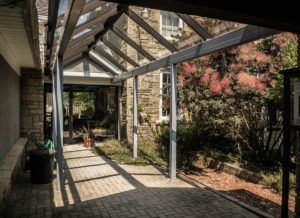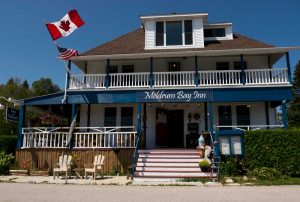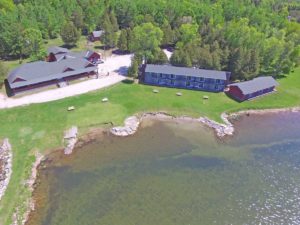Little Lake Huron
Keep an eye out for:
Keen fishermen may find:
- Perch
- Salmon
- Ling
- Trout
- Sharks
- Giant Squid
- Boat Launch
- Swimming










Lake Huron, the second largest Great Lake, spans some 23,000 square miles and has been known to swallow entire ships. Little Lake Huron, located just inland from Hensley Bay on the south shore of Manitoulin, is so small, maybe half a square mile, at best, that most maps don’t even show it, let alone name it and so shallow in most places that you’d be hard pressed to sink a pedal boat.
Infinitesimal Lake Huron might be the more appropriate name.
Bus as soon as I heard about the lake, I just had to check it out. How could you not want to see a lake with such a funny, fanciful name? You pictured toy sized freight ships plying its surface, tiny lighthouses perched on puny headlands, salmon the length of your baby finger?
You wondered if there might also be a Mini Lake Michigan or Lilliputian Lake Ontario to check out once you’d made you tour of this first Un-Great Lake.
Latest on Instagram from
#littlelakehuron
It was a young woman who pumped my gas in Mindemoya, who tipped me off about it. She saw the canoe on my vehicle, and we started talking lakes, and she casually let it drop that she’d recently been out paddling on Little Lake Huron.
“Little Lake what?” I said
“Little Lake Huron,” she repeated.
“Now this, you’re going to have to show me on a map,” I said.
As I paid for my gas she unfolded a Turners map and tried to point out where it was. But it didn’t seem to show up on the map. “It’s somewhere out there,” she said, vaguely waving her hand over a broad swath of the Island’s West End.
When I got home I did a Google search. I did a phrase search, putting the name in quotation marks to ensure I didn’t end up on a page for little fish caught in Lake Huron, or Little Current in Lake Huron, or some other predictable tangent.
I got exactly six hits. One page was in German, and another referred to a different Little Lake Huron in Wisconsin. Who knew there were two? The other four were clearly concerned with the Manitoulin lake my new friend had mentioned. So, she hadn’t been putting me on after all.
One of the sites even included a map, showing how Little Lake Huron Road departs from Highway 540 south of Elizabeth Bay, and winds up at Hensley Bay, near which is Little Lake Huron. I was all set.
But before I left I made a few phone calls to see if anyone in the general area had anything interesting to tell me about the lake. “There’s not much there,” was the typical response. That, and “If you’re going, take some bug repellent.”
Sure, it wasn’t exactly encouraging news, but, undaunted, I packed some Muskol and a bug jacket to boot and set off.
Little Lake Huron Road is easy to find. It’s clearly marked on the south side of Highway 540, about 20 minutes west of Gore Bay, directly across from the turnoff to Pine Haven and just past the entry to the famous Misery Bay Provincial Nature Park. This road, running a bumpy three miles or so, is half the fun of visiting the lake.
Uncannily, the song playing on the car stereo when I turned off onto the road was Mushaboom, by Leslie Peist, which includes the line “I tip my cap to a little dirt road barely on a map.”
The dirt part of Little Lake Huron Road didn’t last long, however. Shortly it became a short clay/sand mixture, pitted with potholes and puddles and then it became flat dark limestone pavement, fissured with cracks and pocked with numerous small depressions that made my tires bounce and teeth rattle and canoe threaten to slip off the roof.
But it was beautiful. This flat rock, technically an alvar, as can also be experienced in abundance at nearby Misery Bay, is a truly unique, almost otherworldly, landscape. As I jounced along I beheld gnarled jack pines growing from the cervices and a profusion of small yellow wildflowers that I later determined were Lakeside Daisies, otherwise known as “Manitoulin Gold,” and a threatened species.
Finally, I found the put-in for the lake, an unmarked grassy break in the forest, and glimpse of water, that occurs just before you reach the big water of Hensley Bay. I suited up in a bug jacket, slathered my hands in bug dope, and slid my canoe in the water.
And promptly got stuck. The water was so shallow here, at the put-in, that I had to frequently step out of the canoe and wade it forward. Soon it deepened, though, and I was off, paddling.
The whole lake is visible in one glimpse. It seemed circular from the water, although on a map it actually has a triangular shape, with two pointy bogs projecting from the northwest and northeast corners, like ears. On the map, the lake looks like the head of a donkey, or a German shepherd (more on that later).
The shoreline is thickly treed, mostly in cedar, and at first the lake looks utterly uninhabited. But a surprising number of camps actually exist here, discreetly tucked among the cedars, all of them, during my visit, seemingly empty. I counted as many as 10 uninhabited camps, and I might have missed one or two.
That’s because I was looking for turtles. When I had spoken with the late well known Manitoulin field naturalist Doreen Bailey, she had told me to keep my eye open for Blanding’s Turtles, which are increasingly rare, and have bright yellow markings on their necks and legs in early summer.
I eventually did spy a turtle, but only the top of its head, no yellow spots, and it quickly disappeared under the surface. Mostly what I saw were dragonflies, zipping around in squadrons, in pairs, on their own, some with shiny blue bodies.
And looking at the dragonflies, I simultaneously realized that my bug jacket and bug dope were unnecessary, there were no mosquitoes. Either the dragonflies were taking care of all of them for me, or it was the strong, steady breeze. Either way, I happily peeled off my jacket.
Why not visit these nearby businesses?
Gore Bay Museum
Meldrum Bay Inn
The Inn at Gore Bay
The bog in the northwestern corner was impassable, fully grown in, but the one in the other corner was easy to paddle through. I followed some serpentine channels and made it nearly to the end, where a deer was browsing on the tall grass and a great blue heron was flapping around in its awkward prehistoric way.
Coming back up the east side of the lake, I suddenly found myself battling strong gusts that sent my canoe scudding annoyingly to one side and the other, and when I got blown into the shallows, my paddle blade would bang on rocks and submerged logs, and my knees were getting sore from kneeling, so I yelled out a colourful complaint into the wind. “Golly darn,” I’ll say I said.
That’s when I realized I wasn’t alone on the lake. Two dogs, German shepherds, nasty looking ones, starting barking in response to my outburst. I let myself drift in to where they were (hey, I’m a dog person), and they charged into the water to greet me, or maybe eat me.
But they were friendly. One even tried to climb into my canoe to show me how friendly she was. Their owners, from Levack, were friendly too.
I beached my canoe and they took me on a bit of a walking tour. We walked to the south end of the lake, where a stream flows under the road and enters Hensley Bay. The distance separating the lake from the bay, Little Huron from Big Huron, can’t be more than 50 yards. In the spring, red fin suckers are thick in this creek, I was told.
Then we walked down to another interesting place, a camp located next door to theirs, where an eccentric Hungarian sculptor named Josef Seris had summered for many years. He also spent one winter in his cottage, which he built himself out of logs.
The building, now owned by someone else, is quite unique, octagonal in shape, with a tacked-on irregular shaped loft. Almost more intriguing to me, though, was the tiny cabin with miniature dormer-like peaks and patchwork shingles that Mr. Seris apparently lived in while building the cottage proper. It looks like something out of a fairy tale, the lair of some wise man with a long white beard, or maybe a hobbit.
Someone else had mentioned this sculptor to me before my trip and remarked that he was fond of eating turtles. I asked about that. “He’d eat anything,” he said with a laugh. “He would make tea just out of leaves that grow around here, and he once made fish soup that had heads in it.
I wondered if all Blanding’s turtle made their way into the eccentric sculpture’s pot, hope not. One day I would like to see these turtles with the bright yellow spots.
In the meantime, my trip to Little Lake Huron has still been worthwhile, seen a deer, dragonflies, the head of a turtle, and two German shepherds. I hadn’t gotten eaten alive. I’d met some friendly folk.
And driving back out, got to look again at the bare black rock strewn with the bright yellow daisies called Manitoulin gold.



